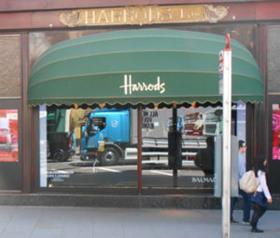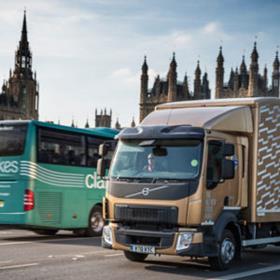With the current focus on truck safety in London, Volvo kindly laid on two distribution trucks for our technical editor to drive so that we could experience for ourselves just what it's like to drive through the city centre on a typical weekday, and how much help the latest technology actually provides.
What we drove: FE-280 18-tonner and an FL-210 12-tonner, both fully laden and with automated transmissions
Time of day: 11am – 5pm
When: 4 June 2015
Route: From Hayes into central London, across to Ealing, back on the North Circular, down to Chiswick, and then M4 back to Hayes.
Both trucks were fitted with almost identical safety equipment. Naturally, all of the usual mirrors were fitted, backed up by a two-camera rear vision system providing views to the rear, and along the near side whenever the left indicator is deployed. This is accompanied by an audible message delivering the message “Attention, this vehicle is turning left”. A nearside proximity detector illuminated a set of miniature traffic lights on the left hand A-pillar when movement is detected, and the FE’s nearside door has a glazed lower panel. However, if you regularly carry a two-person crew, the window is hidden behind the passenger's legs. The only major item missing from the safety kit available was the lane departure warning system, but the value of this in an urban environment is debatable.
The 75-mile driving exercise began and ended at Volvo’s west London dealership at Hayes, just across the M4 from Heathrow airport. After making the short link to the south, the route stuck to the A4 all the way to Trafalgar Square, before a detour down Whitehall, across Westminster Bridge, then via Elephant and Castle before recrossing the river on Tower Bridge.
'Poor signage and no satnav'
Then followed a bit of confusion as poor signage and no satnav meant our target of the North Circular Road was reached by an unexpected route involving the A12. Back on track, we headed to another Volvo dealership near Ealing for quick refreshments and a vehicle change. Back on the North Circular down to Chiswick, then M4 to Hayes, completed the circular route.
Things went relatively smoothly through Chiswick and Hammersmith, with the traffic moving slowly but steadily. The only minor drama was taking the wrong exit from a junction thanks to a pet hate, lane markings only present on the road surface where they are hidden from view by other selfish road users.

The sense of complacency rapidly disappeared as we travelled at considerably less than walking pace along Knightsbridge, giving plenty of opportunities for selfies of our reflection in Harrods’ windows (pictured).
It was also where we saw the first significant amount of potential conflict with two-wheeled road users, as any bit of spare road space was quickly claimed. At these speeds, with plenty of time to scan them, a full set of carefully located fixed mirrors are really as much help as any new technology. However, the default rear view of the camera was helpful in providing an early warning of cyclists about to come into view on one side or another. Even with the monitor mounted in a less than optimal position, any unexpected movement was picked by peripheral vision. Apart from a quick spurt through the Hyde Park underpass, progress all along Piccadilly and Haymarket was painfully slow.
The constant high levels of concentration were beginning to get extremely tiresome; frequently other traffic was literally within a couple of inches of our own bodywork.

One of the greatest challenges when driving in London is deciding if the approaching noise is an emergency siren or an automatic bus. After hearing lots of both, we eventually crossed Westminster Bridge where the traffic began to flow more freely. This medium rate of progress seemed the most dangerous of the trip, as cyclists, easily able to match a truck’s pace, were tempted to undertake, although many just took to the footpath at unabated speed. There were enough flower-strewn lampposts to provide a reminder of the issues.
Once this leg was underway, the left turning aids came into play. When the left indicator is used, the camera view changes to the side, and the audible warning begins. You soon learn to use this as a pre-emptive resource to gain the attention of not just cyclists, but also day-dreaming pedestrians on the edge of junctions. We felt the warning on the FE was set rather too loud, still audible from the driving seat at maximum speed on the motorway, but it certainly made our intentions known, to everyone within a hundred yards. How effective it will be when every truck has it, and it just merges into the general streetscape cacophony, remains to be seen.
Brief driving impressions of the Volvo FE
While the FE proved to be a very effective distribution overall, there were a couple of issues. The steering is a bit slow and low-geared, and although we’re great fans of the I-Shift transmission in general, this probably isn’t the most effective installation. The combination of relatively modest power, and the I-Shift’s preference for moving away in fourth, of 12, and then shifting to seventh, made acceleration lethargic to the point where pulling out into traffic gaps needed careful judgement.
The second leg of the journey, in the FL with the same complement of safety gear, didn’t add much to the safety angle but certainly suggested less is more. Obviously, there was only 75% of the weight to shift with 75% of the power, but the six-speed I-Sync gave much nimbler response and more predictable progress. The only minor criticism is that the engineers responsible for the firm front suspension have obviously never had the dubious pleasure of driving British roads.
Overall, the day provided a useful exercise in understanding the safety issues surrounding the operation of trucks in Central London. Beyond that, though, it reinforced our respect for those drivers who endure the experience every day, delivering the essentials of life to the capital’s inhabitants, while enduring more hostility than gratitude.













